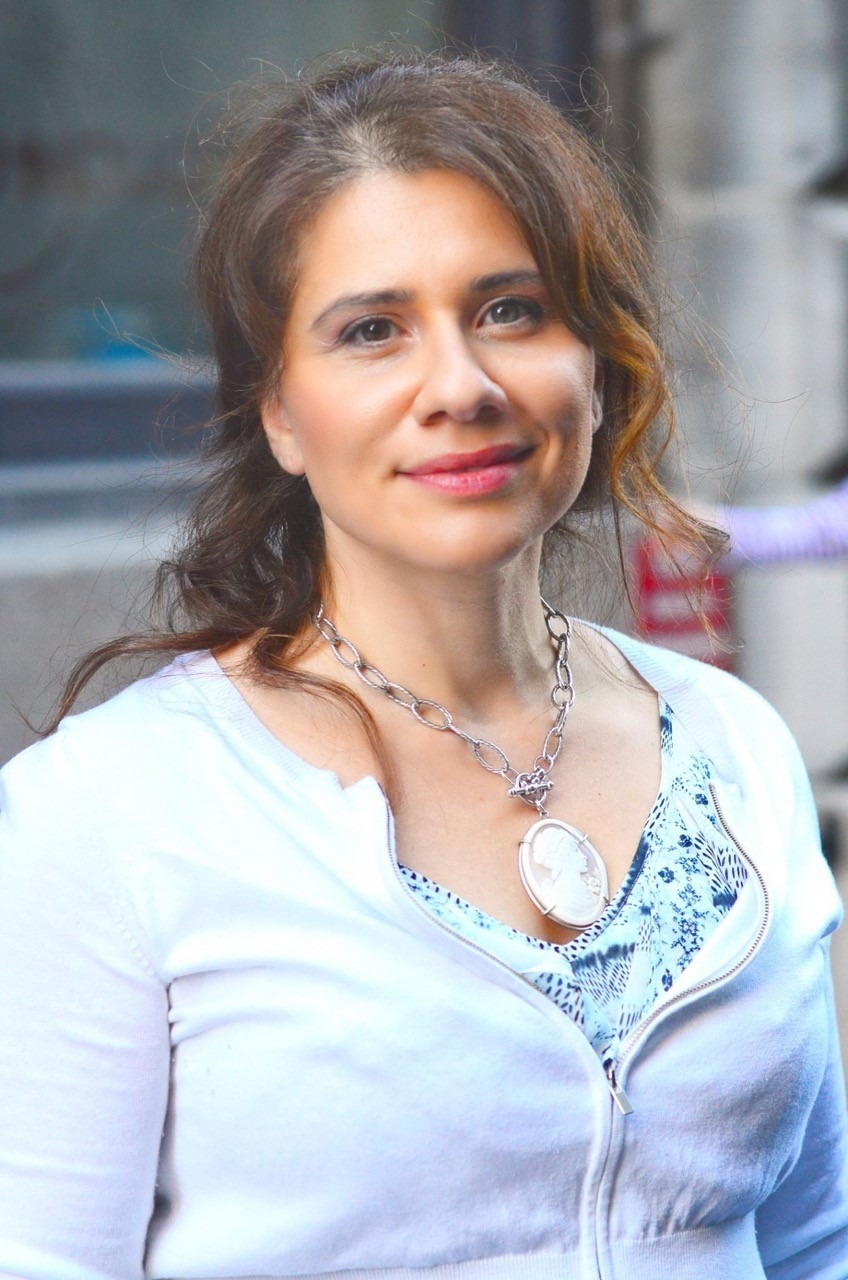
Urban forestry research has been generally classified in two categories: the biophysical and applied areas, and the social science side of things. The biophysical and applied aspects include threats and diseases such as Dutch elm disease, emerald ash borer, ecosystem services (benefits and value), and climate adaptation. The social sciences include human dimensions such as language constructions, unequal access to greenspaces, and creative interventions. The dominant discourses in urban forestry focus on its ecology, its management and its public use.
These narratives include, but are not limited to:
adaptive urban forest planning
economic valuation
green infrastructure
planting mandates, and
modeling (e.g. Geographic Information System, remote sensing)
Less attention is paid to narratives such as language, inequality, art creation, and how civic and social engagement impact and matter in planning and policy processes (Sandberg, Bardekjian & Butt, 2014).
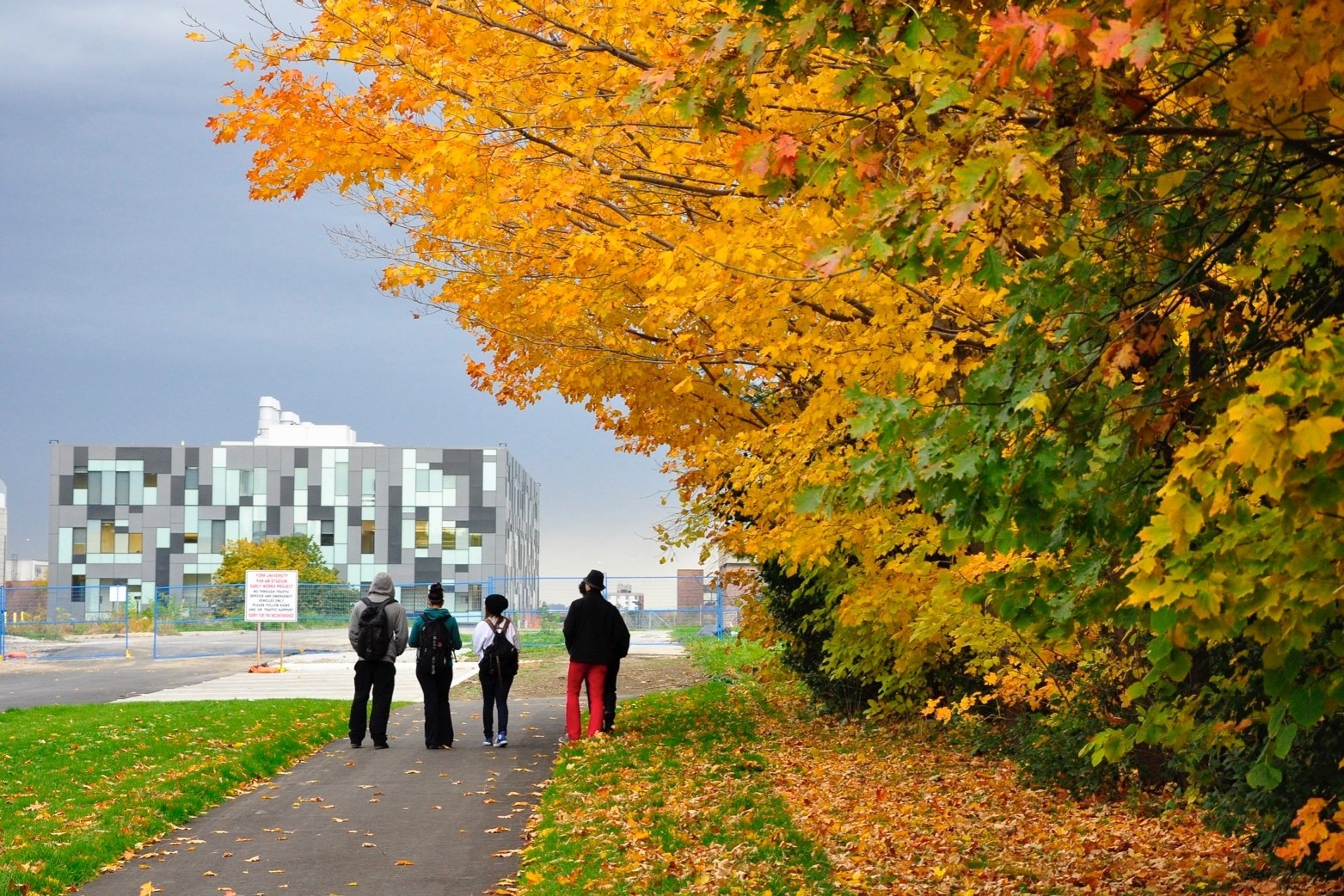
In my first article of this blog series, I stated that research is expanding to include marginal stories; this second entry serves as an introduction to research being done in these areas that explores the themes of environmental and social justice. As presented on November 6th at the Ontario Urban Forest Council annual conference, I will provide four examples:
 The first topic is access and distribution. Research has shown the distinction between ecology in the city and ecology of the city, tying together the notion that urban forests are socio-ecological systems – in social geography and political ecology, this concept has been referred to as metabolism (Heynen, Kaika, & Swyngedouw, 2006), and examines how we consume and experience the urban world around us. Research in urban forestry has advocated that we need more attention paid to issues of justice and nature in the city (Bickerstaff, Bulkeley & Painter, 2009); citizen rights and public access to urban nature (Whitehead, 2009); issues of injustice with respect to greenspace and property (Heynen & Perkins, 2005; Heynen, Perkins & Roy, 2006); and questions of contested benefits of invasive species (Foster & Sandberg, 2004).
The first topic is access and distribution. Research has shown the distinction between ecology in the city and ecology of the city, tying together the notion that urban forests are socio-ecological systems – in social geography and political ecology, this concept has been referred to as metabolism (Heynen, Kaika, & Swyngedouw, 2006), and examines how we consume and experience the urban world around us. Research in urban forestry has advocated that we need more attention paid to issues of justice and nature in the city (Bickerstaff, Bulkeley & Painter, 2009); citizen rights and public access to urban nature (Whitehead, 2009); issues of injustice with respect to greenspace and property (Heynen & Perkins, 2005; Heynen, Perkins & Roy, 2006); and questions of contested benefits of invasive species (Foster & Sandberg, 2004).
Some recent trends include:
mapping distribution – such as comparing canopy cover with socio-economic status in various neighborhoods
Contesting the common ways of practicing and knowing urban forests – for example examining the process of developing urban forest management
Debates about nature vs. society – such as our struggle with identifying ourselves as a part of or apart from the natural world
The notion of curating spaces for public consumption – such as the role of arboreta in fostering urban ecological education
 The second topic is urban agriculture. As community gardens increase, activities are gaining recognition in the urban forestry literature; as such, it is important to consider how this relates to social justice. In June of 2014, a colleague and I were in an underprivileged neighbourhood in East Vancouver to celebrate a recent tree planting event. A group of us were standing around a newly planted seedling discussing its viability, when a man walked out of a methadone clinic from across the street and made his way towards us, waving his arms. He stood next to us and said: “I love trees.”
The second topic is urban agriculture. As community gardens increase, activities are gaining recognition in the urban forestry literature; as such, it is important to consider how this relates to social justice. In June of 2014, a colleague and I were in an underprivileged neighbourhood in East Vancouver to celebrate a recent tree planting event. A group of us were standing around a newly planted seedling discussing its viability, when a man walked out of a methadone clinic from across the street and made his way towards us, waving his arms. He stood next to us and said: “I love trees.”
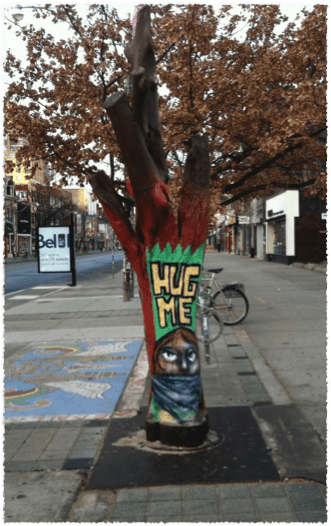
He proceeded to take a leaf in his hand and stroke it, and then he said: “I wish this were an apple tree.” He looked at each one of us pointedly before walking away. That experience inspired us to reflect more deeply about the species we are planting: from an ecological and management perspective this has implications on maintenance (like pest management for example); but the experience served to raise questions about access to food in public areas (Heynen, Kurtz, & Trauger, 2012) and the production and use of edible landscapes (McLain, Poe, Hurley, Lecompte-Mastenbrook & Emery, 2012), and whether we, as curators of urban greenspaces, have a responsibility to make that available where possible. The broader under-represented narrative that this contends with is the presence and use of non-timber, urban forest products (Poe, McLain, Emery & Hurley, 2013).
 My third topic considers agency and affect – how we feel about trees and why that matters. This narrative takes account of non-human nature as an actor (Jones & Cloke, 2002); in urban forestry such agency includes ecological elements, such as invasive species, tree senescence, pests and diseases. These elements create unexpected pathways through which humans view the urban environment – humans are part of the natural world, not separate from it (Peet & Watts, 1996) and trees are integrated in our social fabric, our histories and cultures (Konijnendijk, 2008). As part of my own doctoral research, the notion of agency is dealt with when arborists negotiate their role as nurturers within the urban forest (Bardekjian, 2015). This narrative is important in valuing trees as living organisms on their own terms – apart from what they can provide to humans (i.e. services) or the tendency to personify or anthropomorphize trees. Questions that arise include:
My third topic considers agency and affect – how we feel about trees and why that matters. This narrative takes account of non-human nature as an actor (Jones & Cloke, 2002); in urban forestry such agency includes ecological elements, such as invasive species, tree senescence, pests and diseases. These elements create unexpected pathways through which humans view the urban environment – humans are part of the natural world, not separate from it (Peet & Watts, 1996) and trees are integrated in our social fabric, our histories and cultures (Konijnendijk, 2008). As part of my own doctoral research, the notion of agency is dealt with when arborists negotiate their role as nurturers within the urban forest (Bardekjian, 2015). This narrative is important in valuing trees as living organisms on their own terms – apart from what they can provide to humans (i.e. services) or the tendency to personify or anthropomorphize trees. Questions that arise include:
 How can our emotions towards urban forests and trees better serve the collective space?
How can our emotions towards urban forests and trees better serve the collective space?
What can be done to encourage humans to have more of a  willingness to understand trees on their own terms?
willingness to understand trees on their own terms?
In sum, urban forestry is a multi-tiered actor-network (see Braverman, 2014; Perkins, 2007; Castree & MacMillan, 2001) that includes social actors, the narratives they create, and the urban forest itself.
 The final example centers on creative representations and artistic interventions. Personal and collective expressions of creativity such as visual art and sculpture; photography; film; spoken word performances; art installations (altering streetscapes) are also gaining attention in the fabric of urban forestry awareness and discourse. Dr. Kathleen Vaughan, Associate Professor of Art Education at Concordia University’s Faculty of Fine Arts, examines urban forests through interdisciplinary perspectives and art creation. In a recent exhibition, “Tissus urbains” (2015), Kathleen’s work probed the urban woodlands of Montreal by mapping movement through embroidered mosaics of thread and textile (Figure 1). Her work explores how art creation can influence the future of environmental education and engagement.
The final example centers on creative representations and artistic interventions. Personal and collective expressions of creativity such as visual art and sculpture; photography; film; spoken word performances; art installations (altering streetscapes) are also gaining attention in the fabric of urban forestry awareness and discourse. Dr. Kathleen Vaughan, Associate Professor of Art Education at Concordia University’s Faculty of Fine Arts, examines urban forests through interdisciplinary perspectives and art creation. In a recent exhibition, “Tissus urbains” (2015), Kathleen’s work probed the urban woodlands of Montreal by mapping movement through embroidered mosaics of thread and textile (Figure 1). Her work explores how art creation can influence the future of environmental education and engagement.
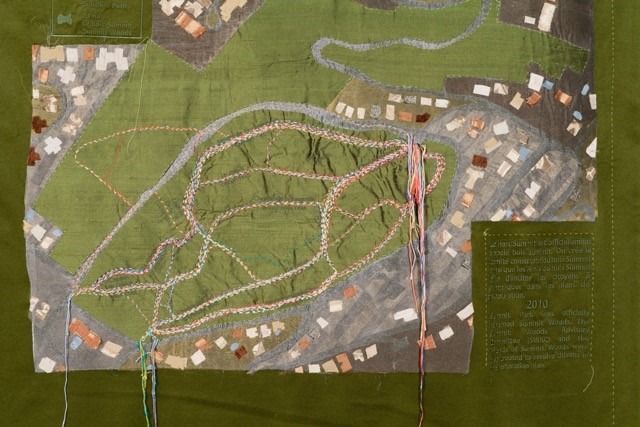
Other examples include: Dr. Paula Meijerink’s “The Urban Forest”, an installation in downtown Montreal. A landscape architect from the Netherlands and visiting professor at the Université de Montréal (UdeM), Dr. Meijerink’s work contests the confines of common urban spaces through design (Figure 2a); Sean Martindale’s “Outside the Planter Boxes” (2010), a Toronto movement attempting to engage communities and highlight neglected city tree planter boxes using creative interventions (Figure 2b); and Noel Harding’s “Elevated Wetlands” (1997), located in Taylor Creek Park in Toronto (Figure 2c); his large-scale pieces of public art as infrastructure explore the complex relationships between social and environmental issues. Artistic interventions can be powerful; they raise awareness by drawing attention to political and social contentions, and in turn inspire action to influence change.
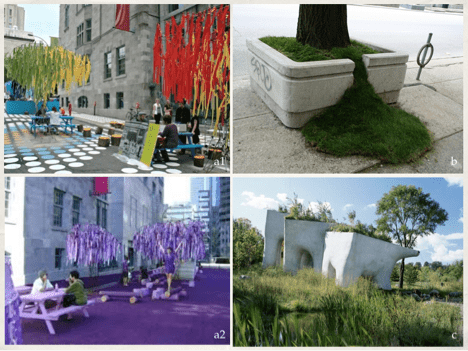
Overall, research is expanding to include marginal narratives.
We are seeing this through the integration of the social sciences in revealing social justice issues. These deeper inquiries and contestations into urban forestry, and urban ecology more broadly, offer unique insights for the field, but such studies are few and far between in Canada. A recent study conducted by Tree Canada (Bardekjian, Kenney & Rosen, 2015) reveals that trends in research are moving towards social innovation and value. There is interest in determining how advocacy groups, non-profits, tree companies and municipalities are working together to ensure the sustainable urban forest practices, policy development and growth in all respects.
The Canadian Urban Forest Network is one of the systems and tools that is currently being better developed to help produce and share knowledge among communities across Canada. In addition, the Canadian Urban Forest Conference (CUFC) serves to foster dialogue on a variety of topics – the 12th CUFC will be held in Laval, Quebec, from September 26th-29th, 2016. Over the course of this blog series, I will delve deeper into some of the themes presented above.
More to come!
Adrina C. Bardekjian, MFC, PhD
References
Bardekjian, A. (2015). Learning from Limbwalkers: Arborists’ stories in Southern Ontario’s urban forests (doctoral dissertation). York University, Toronto.
Bardekjian, A., Kenney, A., & Rosen, M. (2015). The state of Canada’s municipal forest and national municipal needs assessment surveys. Tree Canada and the Canadian Urban Forest Network.
Bickerstaff, K., Bulkeley, H., & Painter, J. (2009). Justice, nature and the city. International Journal of Urban and Regional Research, 33(3), 591-600.
Braverman, I. (2014). Urban trees and actor-network theory. In L. A. Sandberg, A. Bardekjian & S. Butt (Eds.), Urban forests, trees and greenspace: A political ecology perspective, (pp. 132-146). London, UK: Routledge.
Castree, N., & MacMillan, T. (2001). Dissolving dualisms: Actor-networks and the reimagination of nature. In N. Castree & B. Braun (Eds.), Social nature: Theory, practice, and politics, (pp. 208-224). Malden, MA: Blackwell Publishers.
Foster, J., & Sandberg, A. (2004). Friends or foe? Invasive species and public green space in Toronto. Geographical Review, 94(2), 178-198.
Heynen, N., Kaika, M., & Swyngedouw, E. (Eds.) (2006). In the Nature of Cities: Urban Political Ecology and the Politics of Urban Metabolism. London: Routledge.
Heynen, N., Kurtz, H.E. & Trauger, A.K., (2012). Food, Hunger and the City. Geography Compass. 6: 304-311.
Heynen, N., & Perkins, H. (2005). Scalar dialectics in green: Urban private property and the contradictions of the neoliberalization of nature. Capitalism Nature Socialism, 16(1), 99-113.
Heynen, N., Perkins, H., & Roy, P. (2006). The political ecology of uneven urban green space: The impact of political economy on race and ethnicity in producing environmental inequality in Milwaukee. Urban Affairs Review, 42, 3-25.
Jones, O., & Cloke, P. (2002). Tree Cultures: The Place of Trees and Trees in Their Place. New York, NY: Oxford.
McLain, R., Poe, M., Hurley, P., Lecompte-Mastenbrook, J., & Emery, M. (2012). Producing edible landscapes in Seattle’s urban forest. Urban Forestry & Urban Greening 11, 187– 194.
Peet, R., & Watts, M. (1996). Liberation ecologies: Environment, development, and social movements. London and New York: Routledge.
Perkins, H. (2007). Ecologies of actor-networks and (non)social labor within the urban political economies of nature. Geoforum, 38(6), 1152-1162.
Poe M., McLain, R., Emery, M., & Hurley, P. (2013). Urban forest justice and the rights to wild Foods, medicines, and materials in the city. Human Ecology, 41(3): 409-422.
Sandberg, L. A., Bardekjian, A., & Butt, S. (Eds.). (2014). Urban Forests, Trees and Greenspace: A Political Ecology Perspective. London: Routledge.
Whitehead, M. (2009). The wood for the trees: Ordinary environmental injustice and the everyday right to urban nature. International Journal of Urban and Regional Research, 33(3), 662-681.
Back to all articles